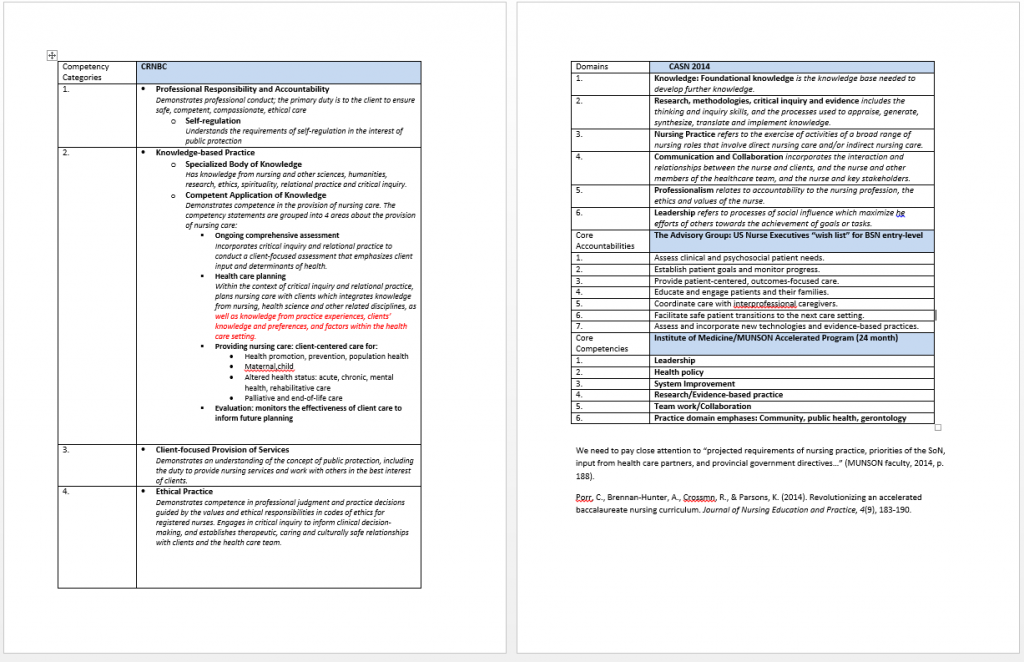by Maura MacPhee
For our brown bag, we continued a discussion from the May 11th EKM workshop on practice competencies and indicators of particular importance for student transition from Term 1 to Term 2 of our accelerated program. There are a number of organizing frameworks for entry-level nursing practice competencies. The one attachment provides an overview of the domains/categories from the College of Registered Nurses of BC (CRNBC), the Canadian Association of Schools of Nursing (CASN), the US (BSN entry-level “wish list” from chief nursing officers across the US), and the Institute of Medicine (The Future of Nursing publication).
The categories from the Institute of Medicine were used as an organizing framework by Memorial University School of Nursing (MUNSON) in Newfoundland. MUNSON is a 24-month accelerated BSN program in Canada. See its website at: http://www.mun.ca/nursing/about_us/. We will discuss a published paper on the MUNSON curriculum re-visioning at our next brown bag.
For a summary of work from our May 11th brown bag, click here. Participants in the May workshop selected specific competencies from our current student practice competencies that we believe are of most importance for beginning students (i.e., transitioning from Level 1 to Leel 2). The numbers in brackets alongside the competencies refer to how they are numbered and located within out student-practice faculty Practice electronic Portfolio (PeP). The PeP is an online portfolio with 21 competencies and numerous indicators per competency. The PeP has not been reviewed since 2007, and the 21 competencies and their accompanying indicators are not prioritized or leveled from term to term. The group needs to pick 2-3 indicators per competency to add to the assessment tool. We will eventually need to agree on categories/domains for PeP competencies and indicators: at present, we don’t have organizing domains or categories for our 21 competencies. Our discussion today was the beginning of a conversation to decide on what type of organizing framework we should adopt as we move forward with our own program’s re-visioning.
Our group will also need to decide on descriptors or a rubric to standardize how we give feedback to students. We currently used a Yes/No approach (yes they meet the competency or no they do not). We agreed during the workshop that we needed something with more specific, constructive feedback. Participants preferred the University of Melbourne 0-4 scale and the UBC clinical performance tool (March 9, Practice Education Advisory Group).
To summarize our practice competency assessment work group tasks to do:
- Select domains/categories as an organizing framework
- Add critical, measurable indicators to our Term 1-to-Term 2 core competencies
- Select descriptors for student performance feedback
We will try to meet every 3-4 weeks over the summer to continue this project work.
A guest from Australia, Professor Patrick Crookes, will be visiting at the UBC School of Nursing on June 26th from 9-11am. Professor Crookes is known for his work on a national Australian practice competency assessment framework known as the Nursing Competency Assessment Tool (NCAST). The NCAST is used by all Australian schools of nursing and nurse employers to assess entry-level competence for BSN-prepared nurses. Australia is also known for its professional development ladder that encourages ENs (enrolled or practical nurses) to obtain their BSN degrees; and BSN nurses to seek advanced educational preparation. Please join us for this session.
We reserved some time during our lunch hour brown bag to discuss changes to our nurse scopes of practice in BC. There are proposed changes (i.e., scope expansion) for LPNs, RNs and RPNs in BC. Our group briefly reviewed this document. I urge all nurse educators to be aware of the proposed changes that will influence what we include in our undergraduate curriculum. The document is at: http://www2.gov.bc.ca/gov/DownloadAsset?assetId=E51110C05BA04AF19120F8CA4681BC4C&filename=final_proposed_changes_to_the_nursing_regulations_mar_25_2015.pdf
I’d love to hear from others. Are these positive changes for our profession? Are they in line with regulatory trends outside BC? Outside Canada?


